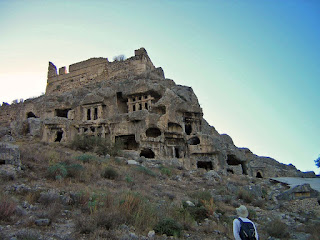 Today is set aside for sailing, swimming and relaxing, and that is exactly what we do. After breakfast, I stroll around the gulet. Our captain is trying to get enough wind to hoist our sails but we are not very lucky this morning. We stop for a swim in a private cove that makes me feel we are the first visitors ever while on the other hand it emanates that kind of old wisdom that so many have been here before us.
Today is set aside for sailing, swimming and relaxing, and that is exactly what we do. After breakfast, I stroll around the gulet. Our captain is trying to get enough wind to hoist our sails but we are not very lucky this morning. We stop for a swim in a private cove that makes me feel we are the first visitors ever while on the other hand it emanates that kind of old wisdom that so many have been here before us.
After lunch, we set out again in Fethiye Bay and this time, the weather gods are with us. All the sails are out, the motor is silenced and the comforting sounds of wind and water take over. I have nestled myself in a solitary spot at the bow, savoring my front row seating and panoramic view. The deep ink blue sea is dotted with paper-like sailboats. On port side, the mainland of Fethiye is shrouded in a haze and I wonder if this is dust or pollution? It is an unforgettable sensation to be at the mercy of the winds billowing the sails and pushing us towards our next and final destination, Göçek.
All too soon the spell is broken. This is where it all ends. Our gulet is moored among hundreds of other boats. The town’s noises of music, people talking and laughing, merchants selling their knickknacks mingle with the smell of food. Our trip has come to an end. We all find it hard to return to reality and we are glad that our poet has found the right words to summarize the impressions we all share. He wrote them down in the ship’s log but he personally read them to us after our last dinner on board:
L Y C I A N D A Y S
Warm thanks to the crew of Almira
And Peter, our eloquent guide,
And the skills of our undaunted drivers
On many a hair-raising drive.
We’ve trekked over pine-scented hillsides,
And swum in a wine-dark lagoon,
And relished fine dishes of mezes
Under a pale crescent moon.
We’ve visited hill towns and harbours,
Where the ancient Lycians arose,
Who buried their dead in stone boxes,
And sat in stone theatres for shows.
The oracle temple at Sura,
Where fishy predictions were granted,
And the Ottoman castle at Kale,
By the glow of the sunset enchanted.
The grand council hall at Patara,
New revealed by the deep-delving spade,
Sidyma, Tlos and Pinara –
Of these names are rich memories made.
John Onley October 2007
Click on the Label Lycian Coast to read my full travel story












